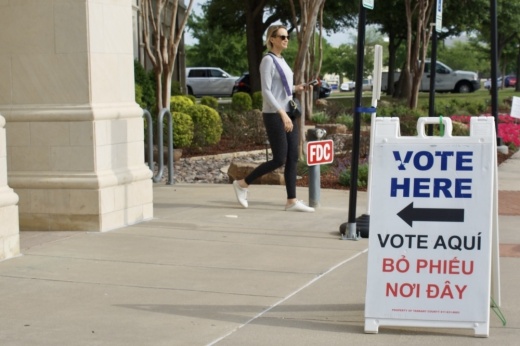Texas will hold Republican and Democratic primaries on March 5 to determine who will be on the ballot in November. If needed, runoff elections will be held on May 28 for races where no candidate wins over 50% of the votes.
Key dates
- Feb. 5: Last day to register to vote or update your information
- Feb. 20: Early voting begins
- Feb. 23: Last day counties can receive applications to vote by mail
- March 1: Early voting ends
- March 5: Primary election day
Texans are required to submit paper voter registration applications. Prospective voters can print an application and mail it to their county’s election office, request an application be mailed to them, or visit their local voter registrar.
Residents may also be able to register to vote when renewing their Texas drivers license or identification card online.
Within 30 days after registering, voters should receive their voter registration certificates in the mail. Certificates contain a voter’s unique identification number, their local voting precinct and information about who represents them at the federal, state and local levels.
Click here to check if you are registered to vote. If you are already registered, you can update your address or name online.
U.S. citizens can register to vote if they will be at least 18 years old by election day, according to the secretary of state’s office. Texans must register in the county they live in.
Convicted felons must complete their sentence, probation and parole before they can register to vote. People deemed mentally incapacitated by a court cannot vote.
To vote by mail in Texas, you must meet at least one of the following criteria:
- You will be age 65 or older on election day.
- You have a sickness or disability that prevents you from voting in person.
- You are expected to give birth within three weeks before or after election day.
- You will be outside your county throughout early voting and on election day.
- You are in jail but otherwise eligible to vote (convicted felons cannot vote).
On the ballot
This year, Texans can cast their votes in the presidential election and a variety of federal, state and local races. Fifteen state Senate seats are up for election as well as all seats in the U.S. and Texas Houses.
Eight statewide races will be on all voters’ ballots, including one for a U.S. Senate seat held by incumbent Ted Cruz, one for Texas Railroad commissioner, three for Texas Supreme Court justices and three for members of the Texas Court of Criminal Appeals. All eight seats are held by Republican incumbents who are running for re-election.
Local positions, such as sheriffs, county tax assessors, county commissioners and justices of the peace will appear on the ballot in some communities.
The primary system
Texans can vote in either the Republican or Democratic primary on March 5. Voters do not need to register with a specific party.
Candidates who get the majority of the votes, or over 50%, in each primary race will face candidates from other parties in November. If no candidate wins the majority during a primary, the two candidates with the highest percentage of the votes will participate in a runoff election on May 28.
The Libertarian and Green parties will hold separate conventions to select their candidates for the November ballot. Texas voters can choose to participate in a single party’s primary election and runoff or convention each election year.
Voter turnout for Texas primaries tends to be significantly lower than the November election. In 2020, the secretary of state’s office reported about 25% of registered voters, or 4.1 million people, voted in the primaries, while nearly 67% of registered voters, or 11.3 million people, cast ballots in November.





